Once-thriving communities have been transformed into quiet shells due to economic decline, natural disasters, or changing times. However, the echoes of their vibrant past often linger through the empty streets and worn-down buildings. Let’s take a look at five ghost towns that hold a special allure, making them well worth a detour or even a dedicated trip to explore.
Turret Town
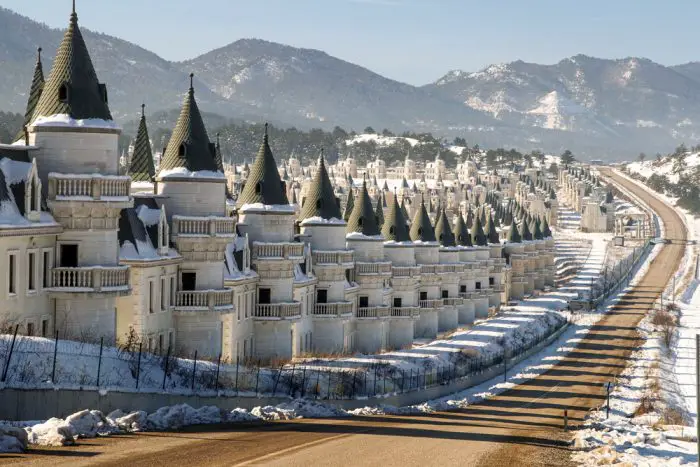
Dreamt up by the Yerdelen brothers from the Sarot Group property development company, a small area near Istanbul was intended to be a fairytale haven called Burj Al-Babas. Envisioned as Turkey’s answer to the Cote d’Azur in France, this Black Sea-adjacent development boasted scenic mountains, verdant valleys, and natural thermal springs.
The concept was imaginative and unique, featuring over 250 acres adorned with castle-like homes inspired by French, American, British, Gothic, and Turkish architectural styles. The lavish setting included opulent spas, entertainment hubs, and upscale dining venues. The clientele primarily consisted of affluent businessmen and investors from the Gulf States.
This ambitious project demanded the effort of 2,500 workers and was slated for a four-year construction timeline to build 732 villas. Commencing in 2014, around 350 villas were sold during the initial phase.
The prices were reasonable by Western standards, ranging from $350,000 to $530,000 per home. Each residence boasted in-floor heating, spiral staircases, intricate moldings, steeples, and balconies. The grand leisure center, characterized by its Neo-classical architecture and adorned with marble pillars, was designed to house conference halls, banquet facilities, traditional Turkish baths, pools, saunas, restaurants, theaters, gyms, and spaces for children’s activities.
Regrettably, the project hit financial setbacks as oil prices plummeted, the Turkish currency depreciated, and the Sarot Group found itself $27 million in debt. Local opposition to deforestation further complicated matters.
The company was forced to declare bankruptcy, rendering 587 completed homes uninhabitable. In 2019, construction efforts resumed with optimism, only to be halted once again by the COVID-19 pandemic.
Nature Reclaims a Town
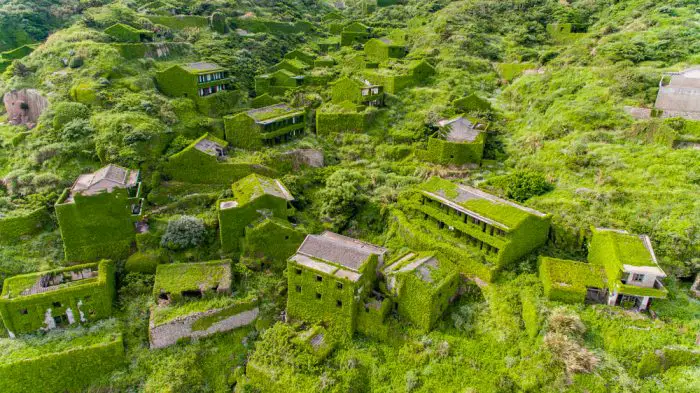
Among China’s numerous ghost cities, one deserted smaller town stands out as particularly captivating. Situated 64 kilometers east of Shanghai, a secluded island named Shengshan emerges from Hangzhou Bay. At first glance, it might appear as an uninhabited expanse of greenery. However, a closer look reveals the distinct presence of around 500 houses sprinkled across the rolling hills.
Houtouwan, an abandoned fishing village, has been reclaimed by the relentless advance of ivy, grass, flowers, and trees. Originating in the 1950s, the village’s decline wasn’t marked by catastrophic events but rather the familiar pattern of economic fluctuations affecting small Chinese settlements. As opportunities in urban areas improved, residents departed the village’s subpar living conditions, scarce resources, limited education, and challenging daily life.
Presently, the abandoned homes remain virtually untouched, now entwined with lush vegetation from the surrounding hills. Peering through the windows, remnants of furniture, photographs, and personal items become visible. A handful of individuals have chosen to remain, despite lacking basic necessities like electricity and running water.
In recent years, the picturesque desolation of the town has drawn photographers and tourists alike. In fact, LIFE magazine dubbed it the Emerald City due to its unique appearance. Seizing the influx of tourists, the remaining inhabitants have turned this boom into a means of survival, offering guided tours, charging admission fees, and selling water—the sole commodity available on the island.
A Crumbling City
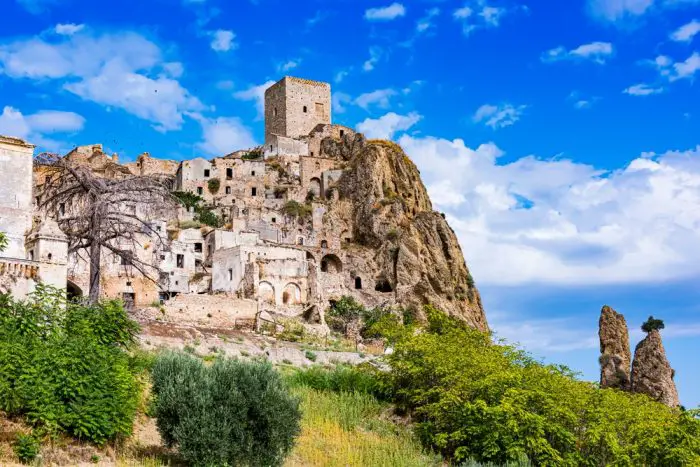
Perched on a steep outcrop in southern Italy’s rugged terrain, the city of Craco has withstood the test of time, serving as a backdrop for notable films such as Quantum of Solace and The Passion of the Christ. The stone structures have weathered thousands of years, enduring development, conflict, disease, and natural calamities. This resilience adds to its undeniable charm.
Craco’s origins trace back to the 8th century BC, and its growth over centuries led to the establishment of a university, palaces, a Norman watchtower, churches, and a monastery. However, adversity struck in 1656 when a plague ravaged the town, followed by the pillaging of brigands.
The region’s susceptibility to earthquakes, landslides, and floods further compounded its woes. The town’s expansion strained the land, consisting of various types of clay that caused frequent slips. Consequently, the population dwindled as people sought better prospects in nearby areas or even emigrated to the U.S.
Today, guided tours permit 35 visitors at a time to explore Craco. Due to the unstable condition of the buildings, visitors are required to wear hard hats to protect against falling debris.
Big Brother Is Watching
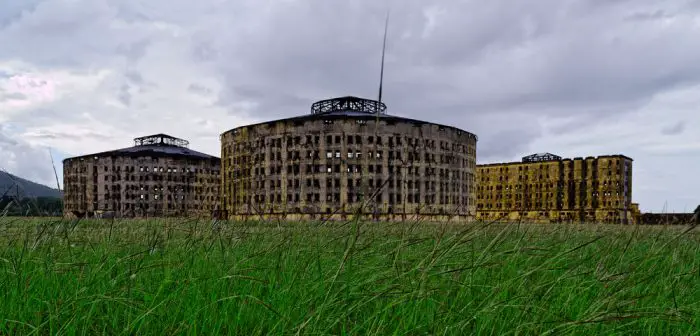
Former Cuban president and dictator Gerardo Machado took paranoia to new heights by constructing an elaborate prison complex in the 1920s. Even within the confines of the prison walls, inmates were meticulously watched. The circular design of the prison blocks, featuring multiple tiers of cells and a central cylindrical observation post, epitomized this panopticon concept. The prison could accommodate up to 2,500 prisoners.
This structure adhered to the panopticon idea, a concept envisioned by 18th-century philosopher Jeremy Bentham, where guards could silently observe prisoners from a central watchtower. This arrangement created an eerie atmosphere throughout the prison complex. Ironically, Bentham believed this architectural principle could be applied to schools and hospitals as well.
Machado’s targets encompassed Jehovah’s Witnesses, homosexuals, and political dissenters. The prison also became a preferred destination for those perceived as potential revolutionaries. However, these incarcerated revolutionaries later transformed the prison into a Communist training ground. Fidel Castro and his brother Raul spent time here, inspiring fellow prisoners and fueling their revolutionary cause.
The prison’s significance dwindled during the 1960s, and it was eventually shut down in 1967. Despite its closure, the site retains its historical value as a national monument, research center, and educational institution.
A Futuristic Ruin
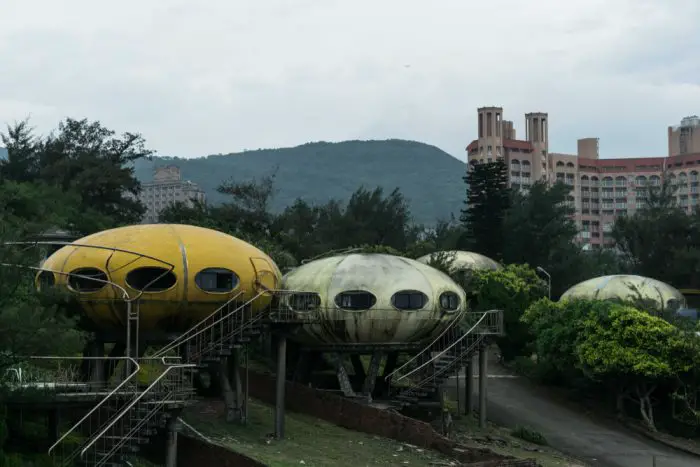
The Wanli UFO Village on Taiwan’s northern coast embodied a futuristic concept far ahead of its time. Envisioned as a unique vacation destination, this village comprised pod-like homes resembling UFOs. Conceived by Finnish architect Matti Suuronen in the 1960s and 70s, these homes, referred to as Futuro houses, sported an eye-catching oval design.
These dwellings featured oval windows, airplane hatch entrances, and vibrant exteriors. Constructed using a blend of concrete and plastic, the homes were lightweight and easily transportable. Suuronen also designed Venturo homes, which boasted rectangular layouts with curved corners. Both types of homes could be found within the village.
Urban explorers find ample fascination while wandering this futuristic ghost town. However, caution is necessary as many elements have succumbed to rust and structural degradation. Construction ceased in the 1980s following a series of accidents and fatalities on the site. Yet, remnants of furniture, glassware, televisions, curtains, and various other items still occupy these abandoned homes.
Another UFO village, the Sanzhi UFO City, shared a similar fate with Wanli but was demolished in 2010. This architectural style remains a rarity today, and enthusiasts have endeavored to preserve these iconic structures. Taiwan is home to many of the world’s last